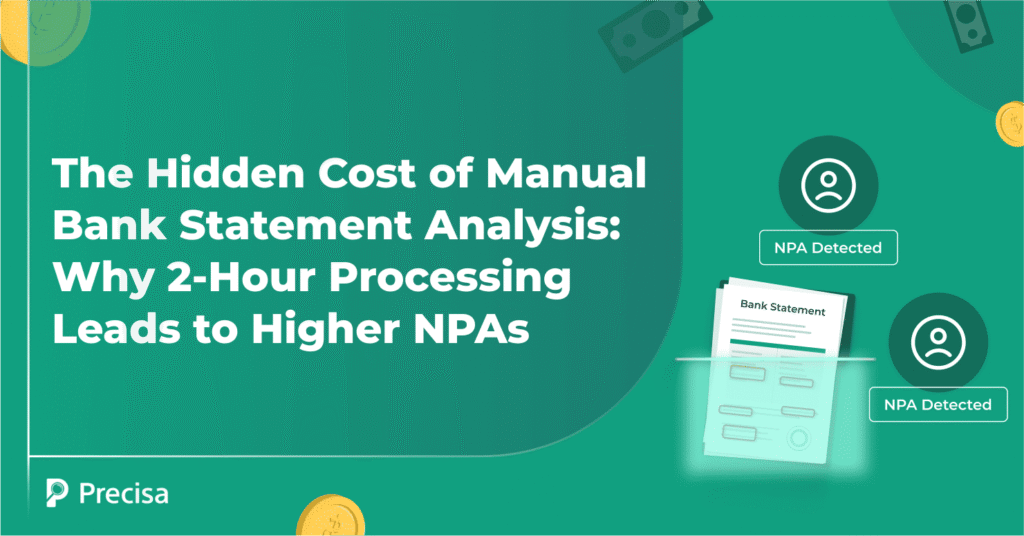The Hidden Cost of Manual Bank Statement Analysis: Why 2-Hour Processing Leads to Higher NPAs

When lenders think of adopting technology, they mainly focus on customer-facing platforms, speed of disbursal, or digital onboarding. But there’s a less visible process that actually carries massive consequences for portfolio health: bank statement analysis. The way NBFCs and DSAs handle this step can make or break the way they detect risky borrowers early.
According to the Reserve Bank of India’s Financial Stability Report, private sector banks achieved a gross NPA ratio of 2.8%. While this has been a multi-year low, stressed assets have been rising in several NBFC segments.
Much of these risks trace back to insufficient or delayed early-stage borrower screening and data processing. Most institutions still check bank statements manually, where analysts take up to two hours to review a single statement. This slows down the process and leaves room for higher NPAs.
Here, we discuss how manual analysis creates hidden costs, why time matters, and how switching to automation and AI solutions can help lenders lower NPAs and defaults.
The Current Reality of Manual Bank Statement Analysis
PwC India’s 2023 industry survey reveals that a substantial proportion of NBFCs still rely on semi-manual processes, which eventually have the following effects:
Two-Hour Processing Time Per Application
DSAs and credit analysts receive bank statements in PDF format. They then manually extract and categorise the data into spreadsheets to calculate income patterns and identify red flags. This process generally takes more than two hours per applicant.
But time is not the real cost. This manual process requires analysts to review every transaction line, categorise expenses, EMIs, bounced checks, and counterparties, and calculate averages without automated validation.
Human Error in Data Extraction
When underwriters manually transcribe transaction amounts and calculate expenses, significant discrepancies are created. For example, a missed decimal point can change INR 50,000 monthly income into INR 5,00,000, completely altering the loan eligibility. In such a case, missed EMI defaults may slip through the review process, creating downstream credit risks.
Inconsistent Assessments
Human analysts interpret data differently, which leads to subjective results. One underwriter may see stable income while another may flag the same profile as irregular. This lack of standardisation results in uneven risk assessment.
Creates Volume Pressure
Dozens of applications are processed during peak lending seasons. Under this pressure, quality of analysis significantly deteriorates. Even skilled analysts, who spend too much time on routine data extraction, lose focus on complex cases that require human judgement and often become bottlenecks.
These operational challenges directly translate into credit risks that impact portfolio performance.
What’s The Direct Connection Between Processing Delays and NPA Risks?
Every hour lost in processing isn’t just inefficiency; but it creates multiple pathways to making poor credit decisions that directly contribute to NPA growth.
Risk of Losing High-Quality Borrowers
The financial sector operates in environments where delays have cascading effects on credit quality. When bank statement analysis takes two hours, loan decisions that should be made within 24 hours stretch into multiple days. This delay forces applicants to seek alternative financing, often from less regulated lenders, while the institution loses good borrowers to competitors that use faster processing approaches.
Compromised Quality and Missed Warning Signals Under Pressure

When reviews are rushed, analysts miss visible red flags. For example, circular transactions, salary parking, and cheque bounces need detailed analysis, but these checks turn shallow under tight deadlines. While verifying income, analysts may overlook expense swings. They may confirm salary credits but miss quick transfers out.
Manual reviews also struggle with categorising overly complicated financial behaviours. FOIR ratios often get miscalculated because recurring obligations across accounts go unnoticed. Missed EMIs and loan return charges slip through when buried among hundreds of entries. Even cheque bounce analysis suffers, with inward and outward cheques mixed up or frequency patterns ignored. All these hide the real financial stress in an applicant’s statement.
The list doesn’t end here. Non-institutional borrowings also escape detection when the focus stays on formal banking activity. Analysing counterparties is another weak spot – monitoring payments and related party transactions means flipping through hundreds of pages, a process prone to blunders under constant pressure.
Similarly, OD/CC usage gets judged by month-end balances instead of daily activity, masking actual credit dependence.
Missed warning signs follow a predictable sequence which manual processes struggle to catch consistently.
Increased Operational and Regulatory Costs
Then there are costs beyond time, such as operational and opportunity costs, and regulatory compliance challenges. For instance, manual reviews drive up costs through hiring, training, and maintaining large analyst teams, while losing revenues from delayed loan disbursals.
They also raise compliance risks, as inconsistent documentation weakens audit trails and leaves institutions exposed to regulatory scrutiny.
This brings us to the most important debate – can automation transform bank statement analysis from a 2-hour burden into a 30-minute risk-intelligence process?
The answer is yes. Modern AI-powered solutions like Precisa can transform this process through artificial intelligence, intelligent data management, and automated financial calculations.
How Precisa Transforms Analysis from Hours to Minutes
Precisa offers a cloud-based, AI-powered bank transaction and financial analytics solution that can reduce bank statement analysis time from two hours to thirty minutes. It is designed by financial experts for decision makers and DSAs in NBFCs and personal finance.
Here’s what Precisa’s bank statement analysis DSA service achieves in thirty minute:
- The system automatically extracts data from over 1000 bank formats, while its advanced proprietary algorithms identify income patterns, expense categories, and cash flow volatility without human intervention.
- The platform’s fraud detection capabilities flag tampered statements, identify circular transactions, and spot salary parking patterns.
- It detects unusual activities like cash deposits on holidays, balance mismatches, and suspicious round-number transactions.
- Assigns a Precisa Score (0 to 1000) that provides an overall creditworthiness valuation by computing multiple financial behaviour indicators. This credit score not only considers income stability but also expense patterns, EMI payments, cheque bounce frequency, and overdraft utilisation.
- Allots a Volatility Score (0 to 1) which measures the cash flow stability to help DSAs and NBFCs assess whether an applicant can maintain consistent EMI payments.
- The platform also tracks all lending relationships across banks and NBFCs to provide a complete picture of an applicant’s debt obligations. It identifies missed EMIs, loan return charges, and bounced EMI attempts.
- It also identifies related party transactions, shell entity payments, and unusual dependent relationships that denote financial manipulation.
- It tracks daily balance to reveal the best EMI debit dates and identify applicants who maintain artificially inflated balances only during statement periods.
- Multi-user functionality allows teams to collaborate on complex cases without compromising access control and data security.
- Precisa’s intuitive bank statement analysis provides comprehensive audit trails with timestamped analysis records for regulatory compliance and the highest documentation standards.
The Takeaway
Bank statement analysis cannot become a liability, as it indirectly weighs on the country’s GDP through a chain of effects, slowing credit flow and investment. For lenders, the hidden costs are even more immediate, as discussed.
By replacing manual methods with Precisa’s AI-powered solution, you can convert the process into an instant, insight-driven inflow. NBFCs and DSAs can focus on complex credit decisions while the platform supports them with routine data checks and suspicious pattern detection.
Schedule a free demo to learn why Precisa is trusted by 300+ NBFCs and DSAs across 15+ countries, and how it can help you grow your revenue.



